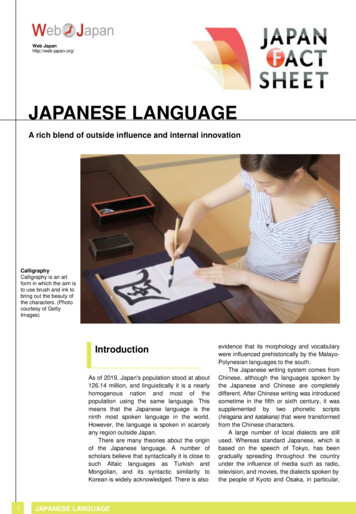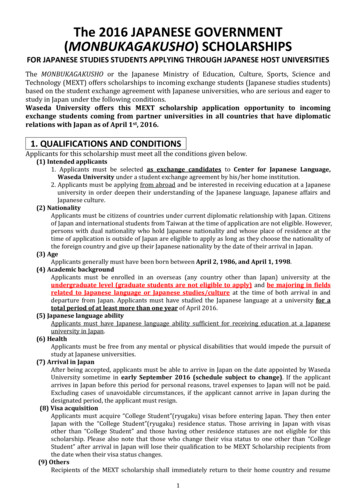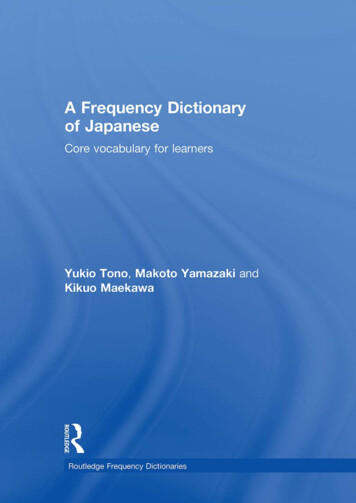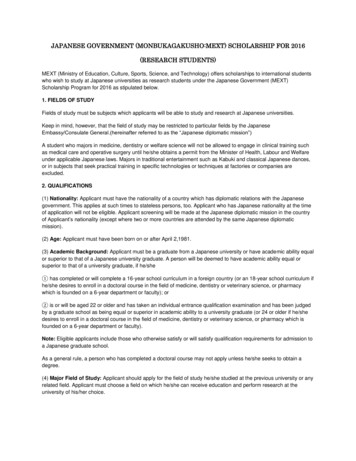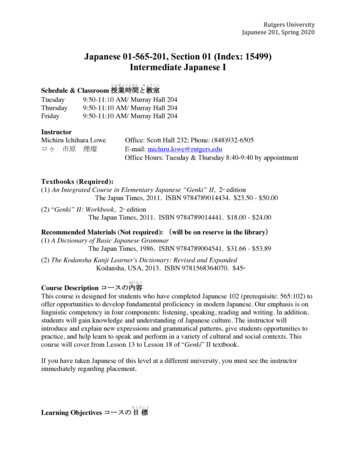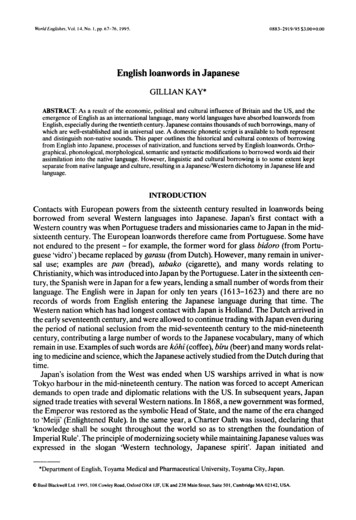
Transcription
0883-29 1919s s3.00 0.00Wor/dOi /is/ies.Vol.14.No. l.pp.67-76. IYY.5.English loanwords in JapaneseGILLIAN KAY*ABSTRACT As a result of the economic, political and cultural influence of Britain and the US, and theemergence of English as an international language, many world languages have absorbed loanwords fromEnglish, especially during the twentieth century. Japanese contains thousands of such borrowings, many ofwhich are well-established and in universal use. A domestic phonetic script is available to both representand distinguish non-native sounds. This paper outlines the historical and cultural contexts of borrowingfrom English into Japanese, processes of nativization, and functions served by English loanwords. Orthographical, phonological, morphological, semantic and syntactic modifications to borrowed words aid theirassimilation into the native language. However, linguistic and cultural borrowing is to some extent keptseparate from native language and culture, resulting in a JapaneseNestern dichotomy in Japanese life andlanguage.INTRODUCTIONContacts with European powers from the sixteenth century resulted in loanwords beingborrowed from several Western languages into Japanese. Japan’s first contact with aWestern country was when Portuguese traders and missionaries came to Japan in the midsixteenth century. The European loanwords therefore came from Portuguese. Some havenot endured to the present - for example, the former word for glass bidoro (from Portuguese ‘vidro’) became replaced by gurusu (from Dutch). However, many remain in universal use; examples are pun (bread), tubuko (cigarette), and many words relating toChristianity,which was introduced into Japan by the Portuguese. Later in the sixteenth century, the Spanish were in Japan for a few years, lending a small number of words from theirlanguage. The English were in Japan for only ten years (1613-1623) and there are norecords of words from English entering the Japanese language during that time. TheWestern nation which has had longest contact with Japan is Holland. The Dutch arrived inthe early seventeenth century, and were allowed to continue trading with Japan even duringthe period of national seclusion from the mid-seventeenth century to the mid-nineteenthcentury, contributing a large number of words to the Japanese vocabulary, many of whichremain in use. Examples of such words are kohl(coffee), biru (beer) and many words relating to medicine and science,which the Japanese actively studied from the Dutch during thattime.Japan’s isolation from the West was ended when US warships arrived in what is nowTokyo harbour in the mid-nineteenth century. The nation was forced to accept Americandemands to open trade and diplomatic relations with the US. In subsequent years, Japansigned trade treaties with several Western nations. In 1868, a new government was formed,the Emperor was restored as the symbolic Head of State, and the name of the era changedto ‘Meiji’(Enlightened Rule). In the same year, a Charter Oath was issued, declaring that‘knowledge shall be sought throughout the world so as to strengthen the foundation ofImperial Rule’. The principle of modernizing society while maintainingJapanese values wasexpressed in the slogan ‘Western technology, Japanese spirit’. Japan initiated and*Department of English, Toyama Medical and Pharmaceutical University, Toyama City, Japan.0 Basil Blackwell Ltd. I YYS. 108 Cowley Road, Oxford OX4 I JF. UK and 238 Main Street.Suite 501. Cambridge MA 02142, USA.
68Gillian Kayeffectively pursued a policy of rapid modernization that would allow the nation to competewith foreign industrial and military powers on equal terms. The policy of isolation fromWestern culture had quickly been replaced by the resolution to learn as much as possiblefrom Western countries.Japan began intensive study of contemporary Western science andtechnology, and related terminologies were constructed or imported (as loan translationsor borrowings). The subsequent adoption of many Western customs and aspects of itsculture was accompanied and aided by an influx of foreign terms into the everydaylanguage, mainly from German, French and English. Foreign culture was studied from theWestern nations which were considered to excel most in certain fields; therefore, medicinewas studied from the Germans, commerce from the British, and cuisine and fashion fromthe French. During the late 1860s and early 1870s,Japan’s elite class began to adopt certainaspects of the Western lifestyle, such as in dress, dining and home furnishing. During theTaisho era (1 9 12-1 926) Western ideas and philosophy came to be accepted and admiredby some of the country’s leading intellectuals. The general population also began togradually add certain aspects of Western culture and customs to their traditional lifestyle.In the 1930s, a government policy of resistance to imported foreign culture led to theofficial exclusion of foreign words from the language during the war years. However, duringthe period of US occupation for the six years after the war, the rebuilding of Japanesesociety was overseen and greatly influenced by the US. Japan once again made concertedefforts to Westernize. Previously banned words were reinstated in the language, and the‘boom’ in adopting foreign culture which became renewed in that period has continued tothis day. The study ‘Nihon no Sankotosho’ (Reference Books on Japan’), published byNihon Toshokan Ky6kai (Japan Association of Libraries) in 1980, showed that over halfthe 25,000 loanwords in Kadokawa’s Loanword Dictionary entered the language afterWorld War Two, most of them from English. Since 1945, aided by an expanding massmedia, thousands of English loanwords have been absorbed into Japanese.LINGUISTIC CHANGE IN BORROWED ITEMSWhen elements of a foreign culture and language are ‘borrowed’ into the culture andlangauge of another, they became adapted to their new cultural and linguistic context. MostEnglish words taken into Japanese show orthographical, phonological, structural orsemantic integration into the native linguistic system. Some distinguishing features of theseprocesses of nativization are described below.OrthographicalchangeEarly foreign loans were assigned Chinese characters according to their pronunciationand/or meaning. For example, the word for Asia, ash, can be written either phoneticallyusing katakana, or with three Chinese characters originally used to represent the syllables a,ji and a. Chinese-derived root words are still available as a resource for creating new terms,in much the same way that English can construct new words from Greek or Latin elements,but it has become more usual to simply transcribe the word into katakana according to itssound. Almost all loanwords are now written in the distinctive Japanese phonetic script,katakana. Examples of borrowed words given in this paper are romanized for convenience,using the ‘Hepburn’ system of romanization developed by the American doctor andmissionary, J. C. Hepburn in the nineteenth century, and now in standard use.Generally, there is consensus over the katakana spelling of loanwords, though some0 Basil Blackwell Ltd. 1995
English loanwords in Japanese69words have variant spellings; for example, iaringu and iyaringu (earring). Sometimes, anEnglish word has given rise to two forms with different meanings, such as airon (a pressingiron) and ‘aim’ (a golf iron). The transcription of the former is unusual, as it was apparentlyinfluenced by the spelling, not the pronunciation, of the English word. It also sometimeshappens that two different English words give rise to the same transcription; thus, both‘bath’and ‘bus’become basu, and ‘grammar’and ‘glamour’ are both transcribed as gurumi.The existence of a domestic phonetic script gives an immediate capacity to absorb anyforeign word into the Japanese linguistic system, even on a temporary basis. One use ofkatakana is to show the approximate pronunciation of non-loan foreign words, such as inthe study of languages and the transcription of foreigners’names into Japanese. In this case,the borrowed words undergo a simple phonetic modification. However, loanwords whichenter the everyday Japanese vocabulary are open to additional types of linguistic change,which are described below. Such change is more liable to occur than with native words,whose pronunciation, meaning and usage have been fixed in the language by centuries ofuse.Phonologica1 changeSpeakers of one language often have difficulty reproducing the sounds of anotherlanguage which do not exist in their own. The borrowing of lexical items containing suchsounds usually entails adaptation of their pronunciation. An example from English is theanglicization of the ‘r’ sound in word such as ‘restaurant’borrowed from French. Similarly,most foreign words inevitably undergo phonetic change when transcribed into Japanese.The Japanese sound system is based on a pool of about 100 syllables. Apart from fivepure vowel sounds (aiue and 0)and the ‘n’sound, all others are consonant-vowel syllables.Borrowed words are adapted to this system. Consonant clusters in English (except thosebeginning with ‘n’) are broken up with vowels, as in fekunosuforesu (technostress), andEnglish loanwords ending in a consonant other than ‘n’ must end in a vowel, as in beddo(bed). Some vowel and consonant sounds in English which do not exist in Japanese arerepresented by the nearest Japanese equivalents; for example, ‘th is usually represented by‘s’ or ‘z’, and the ‘schwa’ sound which is so common in English is replaced in Japanese byone of the Japanese vowels, such as ‘a’.Examples of phonological changes in English consonants are given in the table below:----Sound changechiji ditith ssi shizi jifo hov anHowever, a remarkable development in modern Japanese is the general and official(1980s) acceptance of new syllables created specifically to enable words of foreign origin tobe pronounced closer to their original sound. Most of these have become popularized onlyduring the last few years, and therefore particularly affect the spelling and pronunciation ofwords which have entered the langauge recently. Some are rarely used. Examples of loanwords using these special syllables are given in the table below, with the new syllablesunderlined.0 Basil Blackwell Ltd. 1995
Gillian uchinfakkusu Some loanwords are initials written in Roman script; for example OL (from office lady - afemale clerical worker) and CD. These are always pronounced however, according to theJapanese pronunciation of the English letters, in this case, 6eru and shidi. Acronyms, too,are pronounced as Japanese words; for example, GATT is gatto.Morphological change - abbreviation and combinationThe need to add extra vowels to Enghsh words to accommodate them to the syllabicstructure of Japanese results in some of them becoming very long in the borrowing. Loanwords are often abbreviated, either on or after entering the language. Usually this involvesbackclipping, where the last part of a word is omitted. Blending is also common - the combination of abbreviated words to produce new terms which do not exist in English. Someexamples of backclipping and blending are given below.Backclipping of a word :Backclipping of second word in phrase :Backclipping of first word in phrase :Backclipping of both words in phrase :akuseru (accel[erator])masukomi (mass commu[nication])omuraisu (ome[letl rice)pansuto (pan[tyl stolcking]) Front-clipping is rare; examples are nisu ([varlnish), raoruketro (towell[ing]and homu ([platjform). [blanlket)New combinations of words. There are many unique combinations of English words.These neologisms are known in Japanese as wasei eigo (literally ‘English which has becomeJapanese’).Loanwordpureigaidowanpisuopun k ipepi tesuto6 d i sutoppuhai sensuchiku dansubaton tacchiDerivationplay guideone pieceopen carpaper testorder stophigh sensecheek dancebaton touchMeaningticket officedressconvertiblewritten testlast ordersgood taste in fashionslow dancepassing the baton There are also a large number of loanblends; combinations of words from two differentlanguages.Loanblendhaburashir6rupandenshi renjidenwa bokkusunatsumeroQ Basil Blackwell Ltd. 1995DerivationJ tooth brushroll Portuguese pi0J electronic rangeJ telephone boxJ nostalgic melo[dyj Meaningtoothbrushbread rollmicrowave oventelephone boxnostalgic melody
English loanwords in Japanese carbon J papercuffs Portuguese botioJ morning sham[poo]J butterfly necktieJ circle Dutch gomkibonshikafusu botanasashan ch6nekutaiwagomu 71carbon papercufflinksmorning shampoobowtierubber bandMany words borrowed from basic English vocabulary occur only in compound phrases,their corresponding Japanese word being used to represent the meanings of the words ontheir own. Examples are the word parts deriving from man, woman, boy, girl, baby, car,home, air, tree, sun, food, etc. Examples of words incorporating these basic items are;sururimun (salaried man), kyuriu imun (career woman), bc5ijkrendo (boyfriend), erebetigiru (elevator girl), bebibeddo (baby bed cot), puroki (patrol car), hornusurei(homestay), eukon (air conditioner), kurisurnusu fsurii (Christmas tree), sungurusu (sunglasses) and fisuro f i d o (fast food). The loan item f i d o , for example, is never used on itsown to refer to food in general.Semantic changeBorrowed words inevitably acquire culture-specific meanings, to varying degrees. Itwould be difficult to find a borrowed word which has retained exactly the same meaning orcontext of use as its word of origin. Even a straightforward loan such as konpyiri (computer) has acquired a different context -Japanese computers have bilingual Roman/katakana keyboards and a Japanese-language operating system.The extent of change in meaning varies from a slight change in nuance, to a completelydifferent meaning. Some examples of the latter are given ikingupottoek6shirumansionfront [desk]trumpVikingPotechosealhigh-class block of flatsreception deskplaying cardsbuffet mealthermos flaskacousticssticky labelSome loan phrases have a different meaning from their original, possibly because the component words were taken in separately, and recombined by chance. Examples are moningusibisu (morning service) which in Japanese means a set breakfast served by a restaurant,shc5ro kart0 (short cut) which is a short haircut, and roreningupunrsu (training pants) whichin Japanese refers to sweat pants.Loanwords may acquire a narrower, more specific, meaning in Japanese than they havein their language of origin, or in their Japanese equivalent term. Examples are jkirumu (aroll of film), ekisutoru (a film extra), mishin (only a sewing machine), rsuna (tinned, notfresh tuna), and purin (referring only to caramel custard pudding). Another very commontype of semantic change is where the loanword denotes Western style; the following wordsrefer only to Western-style versions; resurorun (restaurant), kuppu (cup), rebunt (table).Foods which have a Japanese name may be called by their foreign-derived name when prepared Western-style;the Japanese for apple is ‘ringo’, but apple pie is uppunt pui.The existence of words borrowed from a variety of European languages sometimes givesrise to a choice of synonyms and collocations. Words from different languages,but with theQ Basil Blackwell Ltd. 1995
72Gillian Kaysame Latin or Germanic root, have sometimes acquired variant meanings, such as gurasu(from English glass: a drinking glass) and garasu (from Dutch ‘glas’: glass as a material);kappu (from English ‘cup’:a cup) and koppu (from Dutch ‘kop’:a tumbler).Syntactical changeLoanwords are easily incorporated into Japanese sentence structure, for example, byaffixing Japanese grammatical elements. The paradigm ‘this is a pen’, used to teach basicEnglish, translates into Japanese as ‘kore wa pen desu’ (Japanese this subjectparticle pen Japanese is). Most loanwords are nouns, which do not take inflectionalendings. However, many are used as verbs with the addition of Japanese ‘suru’ (roughlymeaning ‘to do’) as in ‘shoppingu SUN’(to do some shopping). Loanwords which areadjectives take Japanese adjectival endings, for example ereganto-nu (elegant), and whenused as adverbs take the adverbial ending ‘ni’, as in ereganto-ni (elegantly). Loan words fitinto the Japanese syntactical structure as if they were native words, being ascribed particlessuch as subject and object markers where necessary. An exception is when a whole phrase isborrowed, as in the expression redl fusuto (ladie[s] first) and man tsli man (man-to-man,one-to-one). In rare cases, such as in an advertising slogan, a whole sentence can be writtenusing English loanwords in the order they would appear in English.CAUSES OF CHANGE IN BORROWINGChanges in form and meaningWords often take on adapted meanings to serve the needs of a changing society. Loanwords are especially open to modification, both on entering the language, and with time.One reason is that the meaning or usage of a word in its original language may not be fullyunderstood; nor need it be, as loanwords are used without reference to their source words.Another is that, with words of foreign origin, there is no deep cultural motivation to protecttheir original meanings. The flexibility of form and meaning of loanwords enables them toadapt easily to the structure of the host language, and current trends and needs.Foreign words written in Japanese script represent one interface between Western andJapanese society. The existence of katakana facilitates the introduction of foreign words,both linguistically and culturally.Linguistically - the practical use of katakanaUsing a domestic phonetic script to transcribe foreign words is clearly more convenientthan creating new combinations of Chinese characters, which would require a consensus orofficial approval before they could come into general use. It gives any individual the abilityand freedom to write an English word in native script, without having to assign or learncharacters for it, nor know its spelling in the original. Transcription is based on the sound ofthe English word, and any foreign word can therefore easily be transcribed into katakana.Thus, Japanese can write down a foreigner’s name immediately by its sound, and, inforeign-language dictation exercises, students may write what they hear first in katakana,and then transcribe back into the foreign language at leisure, after thinking about thepossible meanings of the words and their spellings. Practically, there is no linguistic barrierto the absorption into Japanese of words from other languages.A rapidly developing society constantly requires new vocabulary. When this is taken pre0 Basil Blackwell Ltd. 1995
English loanwords in Japanese73dominantly from other languages, the subtleties of native words can be protected. ModernJapanese society is searching for ways to express itself while maintaining Japanese traditions, no matter what the degree of contact with Western culture. Incomplete linguisticassimilation of foreign loans helps allow Japanese traditional concepts and culture to bemaintained.In many aspects of daily living, Japanese people can freely choose a traditional Japaneseor Western lifestyle. An example of this distinct separation of the two cultures is theJapanese home, which normally has both Japanese- and Western-style rooms, clearlydefined by their structure and furnishings. A house may be basically Japanese style, buthave one or two Western-style rooms; allowing its occupants to enjoy aspects of a Westernlifestyle within a basically Japanese living arrangement. There are also homes which arebasically Western-style, but have one or two Japanese-style rooms. However, the principleis the same - a clear compartmentalization of the two cultures. The language used todescribe the fittings and furnishings of the two types of room is different; Western-stylerooms, for example, having curtains (kiten), while Japanese-style rooms usually havingpaper sliding screens, shoji, at the window. Similarly, the menu of a Western-stylerestaurant or coffee shop may be written almost entirely in katakanized loanwords, whilstthe menu of a Japanese-style restaurant will consist mainly of native words written inChinese characters.Culturally - the Japanese/Western dichotomyThe katakana symbols derive from parts of Chinese characters, and are immediatelyrecognizable in Japanese writing by their bold and simple lines. Katakana thereforephysically separates loanwords from those of native or ancient Chinese origin by representing them in a conspicuously different script. Keeping foreign words compartmentalized inthis way allows the language to gain maximum benefit from their addition to the lexical pool,while protecting the native vocabulary from change. The orthographical separation of loanwords thus enables Japan to develop a Western vocabulary to accompany and assist itsWesternization, without threatening the basic integrity of the native language.Although loanwords are adapted to the Japanese sound system, many ark recognizableas foreign-derived on hearing, for various reasons; (i) they may contain certain sequences ofsyllables which are not common, or unknown in Japanese, (ii) the word may contain a largernumber of syllables than is common for Japanese words, (iii) the words may contain nonnative syllables created specifically to allow foreign words to be rendered in a form nearerto their original (described earlier in this paper, under Phonological change).English loanwords are therefore visually, and to some extent phonologically, recognizedas different from the native vocabulary. This ability for loanwords to be so easily containedmay be one factor why there has been very little attempt to limit their number.Westernization which exists alongside the home culture, rather than replace it, allowsJapanese people a chance to experience aspects of another culture while still having fullaccess to their own.Transference of loan words to Japanese EnglishThe existence of a large number of loanwords derived from English provides a Japaneseperson, regardless of English proficiency, with a resource for communicating with Englishspeakers who do not know Japanese. To what extent, however, are these words comprehensible to non-Japanese? The adaptations in pronunciation, form and meaning described0 Basil Blackwell Ltd. I Y Y S
Gillian Kay74above can be a cause of misunderstanding, or non-understanding, of lexical items. However, there is no doubt that a large corpus of English-derived words within one’s own language has the potential to aid communicationwith English speakers, in a similar way that anative speaker of English can often comprehend words in the romance languages such asFrench, due to their similarities to Latin or French-derived words in English.However, the influence of English loanwords in Japanese on understanding or production of English can also be disadvantageous. There is a general awareness amongstJapanese people that English loans differ from their derivative words, but individuals maynot be aware in detail as to how. Examples of such information about loanwords are:a) whether it is a loanword at all; especially when it is written in Chinese characters, and has anative-like pronunciationb) the language the loan comes fromc) the word the loan comes fromd) the spelling, pronunciation or meaning of the loan in its original languageAs a result, there is often transference from loan usage to English, leading to incorrectexpressions in Japanese English. Typical examples are, ‘I have to go to my arbeit afterclasses finish’ from the word ambaito (German ‘Arbeit’) meaning a part-time job inJapanese, and ‘Do you live in a mansion? from the loan manshon (English ‘mansion’),meaning a block of flats in Japanese and ‘He works as a cock in that restaurant’ from theloan kokku (Dutch ‘kok’) and ‘I’ll meet you at the front of the hotel’ meaning ‘at the reception desk’, which is furonto in Japanese.Thefunction of English loanwords in the Japanese languagea) Many English loanwords name imported things or ideas which did not exist in Japan orJapanese culture previously, such as terminology for Western sports or fashion. The adoptionof Western ideas has also been accompanied by loanwords, such as puraibashi(privacy), whichdoes not have an equivalent term in Japanese.b) Loanwords are often associated with a sophisticated, Western lifestyle, and may be used inplace of Japanese words of equivalent meaning because of their foreign appeal. Their modemimage often makes them preferable to domestic equivalents, where these existc) The existence of many loanwords which have Japanese equivalents provides an alternative toneof discourse. The use of English loanwords is not only a reflection of modem Japanese culture,but also helps serve it by creating a modem atmosphere. They are especially prevalent inadvertising, product names and youth culture.d) Loanwords are sometimes used for special effect, especially in writing, where the angular katakana script catches the eye, and the ‘foreign’words catch the attention.e) In commerce they can be of practical use, not only in advertising and marketing, but also to aidexports; for example, the creation of the name ‘Walkman’has, in addition to giving the product amodem image for Japanese people, perhaps also helped with advertising the product overseas.9 With rapid international information exchange such as news reports, and competition andcooperation in technology, the availability of a common vocabulary is helpful.g) English loans do not have as deep undertones of meaning as native words, and can be used moreeasily to express sentiments or describe situations which may be difficult to talk about inJapanese. Loanwords can have euphemistic value, such as in phrases containing the word shiruba to denote old-age, in expressions such as shirubi shim (silver seat), a seat for elderlypeople by the door on public transport. There is a tendency for the use of loanwords to approach the English usage over time for example, automatic steeringhransmission in a car used to be described by the ‘made-in0 Basil Blackwell Ltd. 1 Y95
English loanwords in Japanese75 Japan’ term no kurucchi (no clutch), but this term was replaced by otorna (from anabbreviation of ‘automatic’). Those with a good knowledge of English tend to use someloanwords with meanings more closely approaching those of the original.English words can easily be borrowed, as they are in the names of companies or products,as with an accompanying katakana reading, customers can read and pronounce them,although often to an approximation of the original pronunciation. Sometimes a loanwordand its derivation appear together, such as in a poster headed with the English word ‘Bargain Sale’ accompanied by bcigen sent in katakana.New foreign loans quickly become popularized by Japan’s highly developed mass media.Japan has a highly literate population, a very large number of weekly and monthly publications, almost everyone has a television, and there is a wide variety of goods in the shops.There are annually published books of telephone directory size explaining terms whichhave recently entered the language. So new words quickly become known, and easily evolvewith changing needs.Whereas in the Meiji era Western lifestyles were adopted only by the elite, now they areavailable to everyone, at all levels of society. Whereas English as a foreign language stilltends to be spoken mainly by the intellectualelite, the use of loanwords from English is not aclass marker. They are used across all society, not as a separate language, but as part of thenative language.The loanword vocabulary, mainly from English ,continues to expand and evolve, servingthe changing linguistic needs of modern Japanese society, and fulfilling an essential role inthe development of contemporary Japanese language and culture.REFERENCESHayes, Curtis (1979) Language contact in Japan. In Sociolinguistic Studies in Language Contact. Edited by W.Mackey and J. Omstein. The Hague: Mouton. pp. 363-376.Heath, Jeffrey (1984) Language contact and language change. AnnualReviewofAnthropology, 13,367-384.Higa, Masanori (1 979) Sociolinguistic aspects of word borrowing. In SociolinguisticStudies in Language Contact.Edited by W. Mackey and J. Omstein. The Hague: Mouton. pp. 277-292.Kachru, Braj B. (1 986) The Alchemy of English: The Spread, Functions, and Models of Non-Native Englishes,Oxford: Pergamon Press.Kachru, Braj B. (1975) Lexical innovations in south Asian English. fnternationalJournal of the Sociology of Language, 4,55-74.Kachru, Braj B. ( 1 985) Standards, codification, and sociolinguistic realism: the English language in the outercircle. In English in the World: Teachingand Learning the Language and Literatures. Edited by Randolph Quirkand Henry G. Widdowson. Cambridge: Cambridge University Press. pp. 11-30.Kachru, Braj B. (1992) World Englishes: approaches, issues, and resources. Language Teaching, 25(1), 1-14.Kay, Gillian S. (1 986) The English in Japanese. English Toduy 6,25-27.Kay, Gillian S. (1989) Gairaigo revisited. English Today, 19,32-35.Kay, Gillian S. (1992a) Gairaigo. In The Oxford Companion to the English Language. New York Oxford University Press. pp. 427-428.Kay, Gillian S. (1 992b) Japan. In The Oxford Companion to the English Language. New York: Oxford UniversityPress. pp. 540-543.Kay, Gillian S. ( 1 995) Loanwords in ContemporaryJapanese. Cambridge: Cambridge University Press.Lehmann, Jean-Pierre ( I 98 1) Japan’s infatuations with the west. History Today, 3 1, 19-24.Morrow, Phillip R. ( 1 986) The users and uses of English in Japan. World Englishes, 6,49-62.Neumann, Wil
‘bath’ and ‘bus’ become basu, and ‘grammar’ and ‘glamour’ are both transcribed as gurumi. The existence of a domestic phonetic script gives an immediate capacity to absorb any foreign word into t

